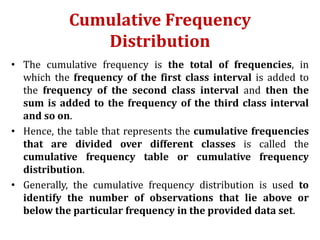Unit 3.pptx
•Download as PPTX, PDF•
0 likes•3 views
Statistics
Report
Share
Report
Share

Recommended
More Related Content
Similar to Unit 3.pptx
Similar to Unit 3.pptx (20)
Frequency Distribution - Biostatistics - Ravinandan A P.pdf

Frequency Distribution - Biostatistics - Ravinandan A P.pdf
Recently uploaded
Differences between analog and digital communicationanalog-vs-digital-communication (concept of analog and digital).pptx

analog-vs-digital-communication (concept of analog and digital).pptxKarpagam Institute of Teechnology
Recently uploaded (20)
Maximizing Incident Investigation Efficacy in Oil & Gas: Techniques and Tools

Maximizing Incident Investigation Efficacy in Oil & Gas: Techniques and Tools
Independent Solar-Powered Electric Vehicle Charging Station

Independent Solar-Powered Electric Vehicle Charging Station
Fuzzy logic method-based stress detector with blood pressure and body tempera...

Fuzzy logic method-based stress detector with blood pressure and body tempera...
5G and 6G refer to generations of mobile network technology, each representin...

5G and 6G refer to generations of mobile network technology, each representin...
What is Coordinate Measuring Machine? CMM Types, Features, Functions

What is Coordinate Measuring Machine? CMM Types, Features, Functions
Call for Papers - Journal of Electrical Systems (JES), E-ISSN: 1112-5209, ind...

Call for Papers - Journal of Electrical Systems (JES), E-ISSN: 1112-5209, ind...
Developing a smart system for infant incubators using the internet of things ...

Developing a smart system for infant incubators using the internet of things ...
Artificial intelligence presentation2-171219131633.pdf

Artificial intelligence presentation2-171219131633.pdf
01-vogelsanger-stanag-4178-ed-2-the-new-nato-standard-for-nitrocellulose-test...

01-vogelsanger-stanag-4178-ed-2-the-new-nato-standard-for-nitrocellulose-test...
analog-vs-digital-communication (concept of analog and digital).pptx

analog-vs-digital-communication (concept of analog and digital).pptx
Working Principle of Echo Sounder and Doppler Effect.pdf

Working Principle of Echo Sounder and Doppler Effect.pdf
Unit 3.pptx
- 1. Cumulative Frequency Distribution • The cumulative frequency is the total of frequencies, in which the frequency of the first class interval is added to the frequency of the second class interval and then the sum is added to the frequency of the third class interval and so on. • Hence, the table that represents the cumulative frequencies that are divided over different classes is called the cumulative frequency table or cumulative frequency distribution. • Generally, the cumulative frequency distribution is used to identify the number of observations that lie above or below the particular frequency in the provided data set.
- 2. Types of Cumulative Frequency Distribution It is classified into two different types namely: 1. Less than cumulative frequency 2. Greater than cumulative frequency.
- 3. Less Than Cumulative Frequency: •The Less than cumulative frequency distribution is obtained by adding successively the frequencies of all the previous classes along with the class against which it is written. •In this type, the cumulate begins from the lowest to the highest size. Greater Than Cumulative Frequency: •The greater than cumulative frequency is also known as the more than type cumulative frequency. •Here, the greater than cumulative frequency distribution is obtained by determining the cumulative total frequencies starting from the highest class to the lowest class.
- 4. Problem 1 (Less than type)
- 6. Problem 2 (Less than type)
- 8. Problem 3 (Less than type)
- 10. Problem 4 (More than type)
- 12. Problem 5 (More than type)
- 14. Measure of Central Tendency • Usually when two or more different data sets are to be compared it is necessary to condense the data, but for comparison the condensation of the data set into a frequency distribution and visual presentation are not enough. • It is then necessary to summarize the data set in a single value. • Such a value usually somewhere in the center and represent the entire data set and hence it is called measure of central tendency or averages.
- 15. Types of Measure of Central Tendency: 1. Arithmetic Mean 2. Geometric Mean 3. Harmonic Mean 4. Mode 5. Median
- 20. Problem 2
- 21. Solution:
- 22. Problem 3
- 27. Problem 4
- 33. Problem 5
- 37. Mode
- 41. Problem: Find the mode using this data Solution: Mode is 15
- 44. Problem 5
- 48. Median